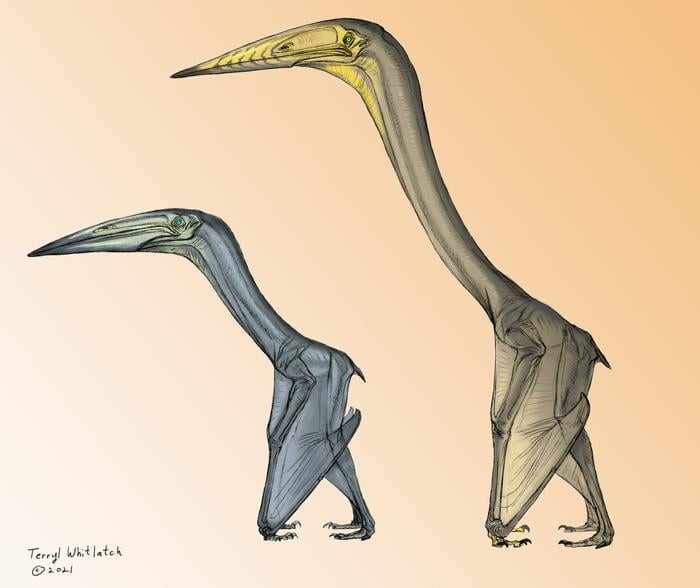Summary: A groundbreaking study of well-preserved pterosaur fossils from Jordan suggests that different species of these ancient flying reptiles had distinct flight styles, ranging from flapping to soaring.
Estimated reading time: 7 minutes
Paleontologists have long debated the flight capabilities of pterosaurs, especially the largest species of these extinct flying reptiles. Now, a new study published in the Journal of Vertebrate Paleontology offers compelling evidence that not only could large pterosaurs fly, but they likely employed different flight strategies depending on their size and anatomy.
Researchers from the University of Michigan, Jordanian institutions, and the Saudi Geological Survey analyzed rare three-dimensional fossils of two large azhdarchoid pterosaur species discovered in Jordan. These exceptionally well-preserved specimens, dating back to the Late Cretaceous period (about 72 to 66 million years ago), have provided unprecedented insights into pterosaur flight mechanics.
Why it matters: Understanding how pterosaurs flew is crucial for our comprehension of the evolution of flight in vertebrates. This research not only confirms the flight capability of giant pterosaurs but also suggests a diversity of flight styles within the group, potentially reflecting different ecological niches and adaptations.
Unveiling Ancient Flight Strategies
The study focused on two pterosaur specimens: a newly discovered species named Inabtanin alarabia, with a wingspan of about 5 meters, and new fossils of the already-known giant Arambourgiania philadelphiae, which had an estimated wingspan of 10 meters.
Dr. Kierstin Rosenbach, the lead author from the University of Michigan, expressed her excitement about the findings: “The dig team was extremely surprised to find three-dimensionally preserved pterosaur bones, this is a very rare occurrence. Since pterosaur bones are hollow, they are very fragile and are more likely to be found flattened like a pancake, if they are preserved at all.”
Using high-resolution computed tomography (CT) scans, the researchers were able to analyze the internal structure of the wing bones in detail. This analysis revealed striking differences between the two species, suggesting distinct flight styles.
Flapping vs. Soaring: A Tale of Two Pterosaurs
The internal structure of Inabtanin alarabia’s wing bones showed a pattern of crisscrossing struts similar to those found in modern flapping birds. This structure is adapted to resist the bending loads associated with flapping flight, indicating that this smaller pterosaur likely flew by actively flapping its wings.
In contrast, the humerus of the larger Arambourgiania philadelphiae exhibited a series of spiral ridges along the interior of the hollow bone. This structure closely resembles that found in the wing bones of modern soaring birds like vultures. The spiral ridges are thought to help resist the torsional forces experienced during soaring flight.
Dr. Rosenbach noted the unexpected nature of this discovery: “The ridges in Arambourgiania were completely unexpected, we weren’t sure what we were seeing at first! Being able to see the full 3D model of Arambourgiania’s humerus lined with helical ridges was just so exciting.”
Implications for Pterosaur Ecology and Evolution
The discovery of diverse flight styles in differently-sized pterosaurs opens up new questions about the relationship between body size, flight style, and ecological niche in these ancient reptiles.
Professor Jeff Wilson Mantilla, a co-author of the study, suggests that “variations likely reflect responses to mechanical forces applied on the pterosaurs’ wings during flight.” This implies that the flight style of a pterosaur species may have been influenced by its size, habitat, and lifestyle.
Dr. Rosenbach hypothesizes about the evolution of these flight styles: “If we look to other flying vertebrate groups, birds and bats, we can see that flapping is by far the most common flight behavior. Even birds that soar or glide require some flapping to get in the air and maintain flight. This leads me to believe that flapping flight is the default condition, and that the behavior of soaring would perhaps evolve later if it were advantageous for the pterosaur population in a specific environment; in this case the open ocean.”
Challenges and Future Research
While this study provides valuable insights into pterosaur flight, many questions remain. The rarity of well-preserved pterosaur fossils makes it challenging to draw broad conclusions about flight styles across different species and time periods.
Additionally, the complex interplay between body size, wing shape, and flight style in pterosaurs is not fully understood. Future research could focus on:
- Analyzing more pterosaur species to see if the patterns observed in this study hold true across the group
- Investigating how flight styles might have evolved over time in pterosaurs
- Using computational models to simulate pterosaur flight based on these new anatomical insights
Dr. Rosenbach concludes: “This study provides a framework for further investigation of the correlation between internal bone structure and flight capacity and behavior, and will hopefully lead to broader sampling of flight bone structure in pterosaur specimens.”
As paleontologists continue to unearth and analyze pterosaur fossils, we may gain an even clearer picture of how these fascinating creatures once ruled the prehistoric skies.
Quiz:
- What is the name of the newly discovered pterosaur species mentioned in the article? a) Arambourgiania philadelphiae b) Inabtanin alarabia c) Pteranodon longiceps d) Quetzalcoatlus northropi
- Which flight style is associated with the larger pterosaur, Arambourgiania philadelphiae? a) Flapping b) Gliding c) Soaring d) Hovering
- What technology was crucial in analyzing the internal structure of the pterosaur wing bones? a) X-ray diffraction b) Electron microscopy c) High-resolution computed tomography (CT) scans d) Magnetic resonance imaging (MRI)
Answer Key:
- b) Inabtanin alarabia
- c) Soaring
- c) High-resolution computed tomography (CT) scans


